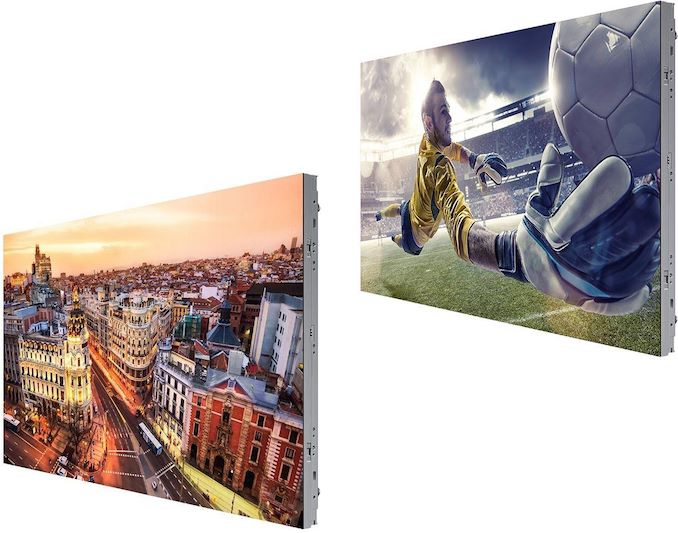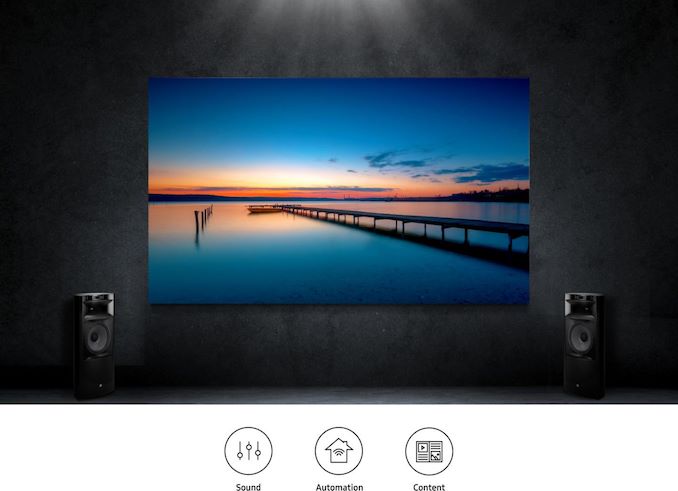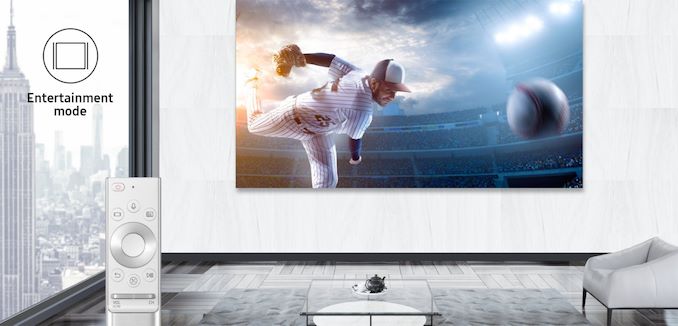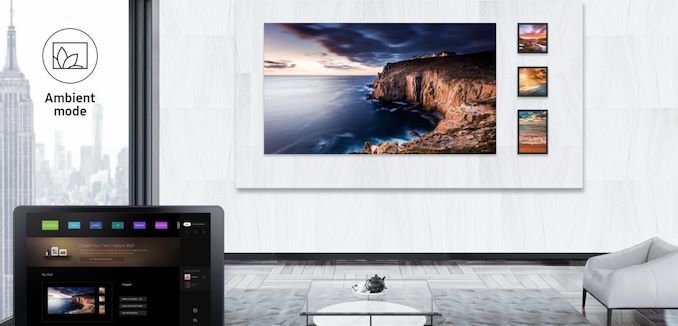Samsung’s Micro LED Wall TVs Now Available: Up to 8K, Up to 292-Inches
by Anton Shilov on October 3, 2019 9:15 AM EST
Samsung has started global sales of its Micro LED-based 'The Wall' display systems. The Wall televisions will be available in multiple configurations, but customized according to individual orders. The most basic Wall will offer a Full-HD resolution as well as a 73-inch size, wheareas the most advanced model will feature an 8K resolution and a 292-inch size.
Samsung’s The Wall televisions (IW008R) rely on the company’s bezel-less 806.4 × 453.6-mm Micro LED cabinets with a 960×540 resolution as well as 0.84-mm² individually-controlled LEDs. The building blocks feature 250 - 2000 nits brightness (regular/peak), around 10,000:1 contrast ratio, a 16-bit color depth, up to a 100/120 Hz refresh rate, as well as 155°/135° horizontal/vertical viewing angles. The modules also feature Samsung’s Black Seal and Ultra Chroma technologies to further improve contrasts and color saturation.
The Wall TVs come with a multimedia box based on Samsung’s Quantum Processor Flex SoC that supports a 20-bit internal processing, AI upscaling, video decoding, various HDR modes (HDR10+, LED HDR), and can run a variety of applications (Bixby, Netflix, YouTube, SmartThings, etc.).
As in case of competing Micro LED-based TVs, resolution of Samsung’s Wall televisions depends on their size. The Full-HD version uses only four cabinets and measures 73 inches in diagonal. By contrast, the 4K Full-HD model relies on 16 modules and therefore measures 146 inches. 6K and 8K Wall TVs feature 219-inch and 292-inch diagonals, respectively. Samsung can build non-standard bespoke Micro LED TVs as well for those who need them.
Samsung does not disclose pricing of its Wall televisions, but asks interested customers to contact it for an individual offering. That said, it is pretty obvious that pricing of Samsung’s Micro LED TVs will be well above MSRP of its ultra-premium QLED 4K or 8K televisions.
Related Reading:
- Sony’s Micro LED-Based Ultra-HD TVs Available to Consumers: 2K to 16K Resolutions, up to 790-Inches
- TCL Shows Off 132-Inch Micro LED 4K UHDTV: 24,000,000 Micro LEDs
- Sony Develops 16K Display: A 783-Inch ‘Crystal LED’ Screen
- Samsung at CES 2019: 219-Inch and 75-Inch Micro LED Ultra-HD TVs Demonstrated
Source: Samsung (via MicroLED-Info.com)














33 Comments
View All Comments
bubblyboo - Thursday, October 3, 2019 - link
"around 10,000:1 contrast ratio""as well as 155°/135° horizontal/vertical viewing angles"
So micro led is a dud too then?
danjw - Thursday, October 3, 2019 - link
These are first generation products.Commenter3000 - Friday, October 4, 2019 - link
Wrong, the figures are wrong.Check the author's own sources.
Commenter3000 - Friday, October 4, 2019 - link
No, you're right, the figures quoted by this guy are wrong.Contrast: infinite
Viewing angles: Very high, just like OLED (179)
The OP is a moron, if you search on the links the author himself referenced at the end it clearly states "perfect black" which means infinite contrast.
Dr. Madness - Saturday, October 5, 2019 - link
Look there, God's perfect idiot...If you were not such a completely and absolutely incompetent ass you would have noticed that the links the author himself referenced at the end also list the specs with exactly the viewing angle and contrast ratio numbers quoted by the author.
Guys, don't be that guy.
s.yu - Sunday, October 6, 2019 - link
Indeed the source, below "related reading"(it should be above to reduce confusion), says those numbers, but Samsung's PDF says otherwise.Also in the source below I noticed:
Color Temperature - Default
8,500K+-1,000K(floating Bin)
That sounds like an eye-searing white point, and its adjusted minimum is 6500K barely acceptable and not recommended for use before sleep.
bhtooefr - Sunday, October 13, 2019 - link
Keep in mind that a lot of CRTs ran a default 9300 K white point (really, this is because of Japan standardizing on 9300 K, as well as making a lot of CRTs) and things were... fine.xenol - Thursday, October 3, 2019 - link
Is this even microLED? The really low PPI doesn't make it sound like such.Kevin G - Thursday, October 3, 2019 - link
It is on the edge of what can be considered microLED as it isn't just about pixel pitch. The distinction generally comes from how the LEDs are mounted on the board. MicroLEDs use new techniques for density and individual LED are no longer serviceable for replacement. A single dead pixel in a more traditional LED will just have that one LED replaced in a module at a service lab and then sent back. If I had to guess, each 960 x 540 pixel cabinet leverages 60 x 60 pixel microLED tiles mounted inside of it. So a single dead pixel would ultimately result in a 60 x 60 section being replaced on the module board.xenol - Thursday, October 3, 2019 - link
It seems really misleading to call it "micro" if the pixel pitch isn't even on a micrometer scale.